Mark Mansfield, racing consultant and agent for UK Sailmakers Ireland, gives Afloat.ie readers ten top tips on helming techniques. It's an area where he has extensive experience, having competed in four Olympic Regattas, over 30 World and European Championships in various classes, Commodores Cup Admirals Cup boats and many others.
Tip No 1 In lighter airs, steering upwind, try and steer to a higher telltale than normal. If you steer to the lower, normal telltale, you will find in lighter air that the upper forward area of your jib is luffing a bit and as a result power is lost. Better to steer to an upper telltale, even if the lower telltale is telling you to come up. You may initially find you are sailing a bit lower, but you should be faster and that extra speed will then allow you to put the bow up again. The biggest mistake in light airs is to pinch too much. Telltales are a powerful tool to help with sail trim. There are two types of telltales, luff and leech telltales. Luff telltales show what is happening with the wind as it goes over the luff of the sail. Instead of waiting for the sail to luff and slow you down, using the telltales allows you to correct the sail trim before the sail flaps. Use your telltales to help trim the sail and help with your steering upwind.
Tip No 2 In Strong winds (say over 15 knots), you should really be steering mainly to heel, and not to the telltales. Yes, keep an eye on the telltales, but it is very important not to be overheeled, which allows the boat to slip sideways. If the heel gets too much, try and sail a bit higher until it gets back to the normal heel angle.
 Heavy air sailing in a Flying fifteen 20-foot keelboat Photo: Afloat.ie
Heavy air sailing in a Flying fifteen 20-foot keelboat Photo: Afloat.ie
Tip No 3 No 2 point leads me on to the art of scalloping. Every top helm develops this. It is the ability to be sailing upwind quickly at a normal angle and then to take a 5 degree or so luff up for a few seconds, without losing speed, and then to bring the boat back again onto the original Normal angle, thus achieving a half boat length or so benefit to windward. Often this is achieved when the helm feels a gust just hitting the boat and rather than react by pulling on the helm(and creating drag) he does the opposite, and lets the bow drift up towards the wind for a few seconds, waits for the boat to get to the correct heel, then pulls the bow away again slowly to the angle that has a normal helm angle. All of this results in a gain to windward, with little, if any, speed loss.
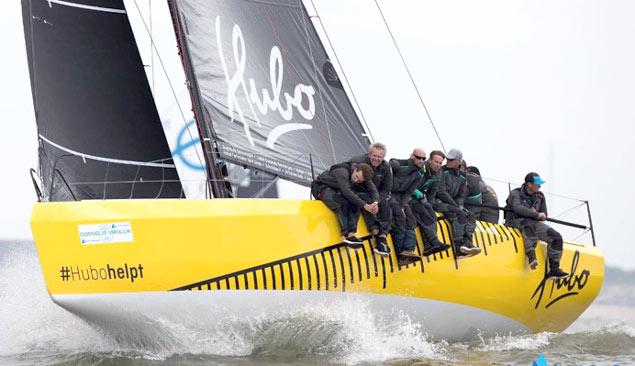 Hubo, Going upwind on a knife edge. Uk Uni Titanium Jib and main
Hubo, Going upwind on a knife edge. Uk Uni Titanium Jib and main
Tip No 4—Most boats should have 3-5 degrees of weather helm in medium winds, to allow the rudder to provide lift. The Yacht Designer would have positioned the mast and keel to achieve this originally, so it is important that your boat still has this. If not, it could be that your mast rake or sail size is not correct. Your Sailmaker or Professional sailor could help you out with this if your boat either has little or no helm, or too much helm. In Light winds, often there won't be much weather helm, and moving crew weight to leeward is often needed to heel the boat and start providing some feel to the helm. It is important though, once weather helm starts to come back, that crew who were to leeward are gradually moved back to the high side.
 Fools Gold, On a lovely heel angle, sailing upwind
Fools Gold, On a lovely heel angle, sailing upwind
Tip No 5-- If you steer with a wheel, you should have 3 clearly obvious marks on the helm. At the very top of the wheel, in the middle should be a mark showing the rudder centralized. Then either side of this should be a mark showing say 4 degrees of helm. The reason for this is so that the helm, and in particular the mainsheet trimmer, can look and see how heavy the helm is, particularly in medium and strong winds. The mainsheet trimmer should be looking to see, going upwind, that the side mark is now in the middle, showing the boat has circa 4 degrees of helm. If he notices that it has gone beyond that, then he should be depowering the main by dropping Traveller a bit or extra backstay. To find a 4-degree position on the wheel, you could use a protractor on the quadrant or else a protractor on the rudder when the boat is out of the water.
 A tiller-steered Beneteau 31.7 on Dublin Bay Photo: Afloat.ie
A tiller-steered Beneteau 31.7 on Dublin Bay Photo: Afloat.ie
If you steer with a tiller, then you just have to work out the 4-degree angle and visually get a feel for when the tiller is too high.
Tip No 6 When tacking, especially in stronger winds, one of the biggest mistakes is turning the boat too far after the tack. This results in it being very hard and slow for the crew to winch in the Genoa or Jib. The boat then goes sideways, the helm gets too heavy, and the boat then semi broaches back up into the wind. All the time getting slower. If you don’t have a good feel for where to point the boat after the tack, try and work it out mathematically. Before the race go onto each tack upwind, and check your heading on both tacks. The difference between the two tacks is your tacking angle. So say you are tacking through 80 degrees. During the race, before you tack, look to windward about 80 degrees from where you are heading and see if you see a point on the land, or maybe another yacht and set that as where you should be pointing after the tack.
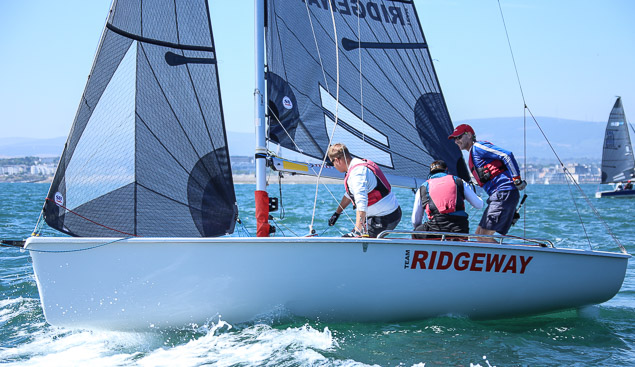 SB20 and All Ireland champion Peter Kennedy completes a tack Photo: Afloat.ie
SB20 and All Ireland champion Peter Kennedy completes a tack Photo: Afloat.ie
Tip No 7—How to tack. Tacking isn’t just a matter of putting the helm over. There are various different speeds that should happen to the movement of the helm during a tack, particularly in medium and strong winds.
In Light airs, it likely will be a smooth similar movement as the important thing is to get onto the new tack quickly and not lose speed too much through the tack. In lighter airs, always come out a bit lower than your normal angle, in order to build speed after the tack. When the speed builds a little, and some feel comes into the helm, then the bow can be put up again to the normal angle. In stronger air, there is a different technique. Initially, going into a tack, let the bow come up 5 or 10 degrees slowly which allows you to gain to windward, then it needs to go through up to head to wind and beyond fairly quickly. Finally, beyond head to wind, you should slow down for a second to allow the Jib sheeting crew to gather in the slack of the Jib sheet, then you press the boat further to the Normal windward angle. This allows the Jib to be sheeted in quicker. It is very important, for the balance of the boat, that the Jib gets sheeted in quickly as if not, too much weather helm will result if the Jib is loose and the main is in and that is slow. If a tack is not good and the jib does not come in quickly, the mainsheet person should ease the main a bit to help the Helm with his likely weather helm problem.
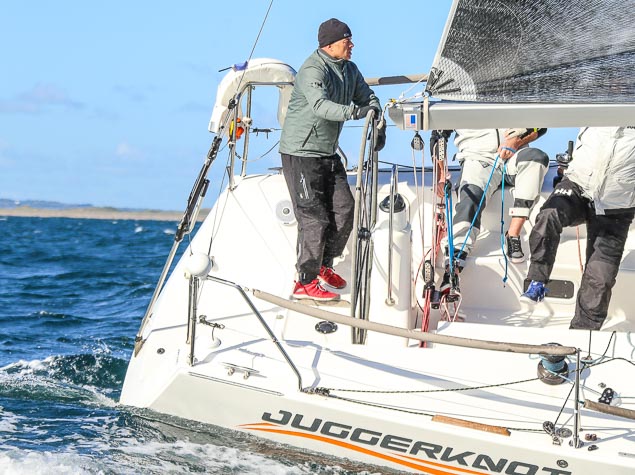 J109 National Champion Andrew Algeo at the helm of Juggerknot Photo: Afloat.ie
J109 National Champion Andrew Algeo at the helm of Juggerknot Photo: Afloat.ie
Tip No 8—Wheel steering—A wheel does not have the same feel as a tiller and it is important not to grip the wheel hard with little wheel movement. Very often I can see owners sitting on the side, holding the wheel, often in strong winds and big waves, with very little movement of the wheel. I nearly always stand when steering with a wheel in stronger, big sea conditions, as it allows you to make larger movements of the wheel than you can do if you are sitting. Also, it allows you to see over the sitting out crew so you see oncoming waves and gusts, and react to them before they hit you.. Very many wheels nowadays have gearing that allows small wheel adjustments to be made easily, but in order to make a 10-degree adjustment, it may need 2 or 3 feet of wheel movement and that is very difficult to do while sitting. In flat water, sitting may be fine as there is not as much adjustment needed, but I still favour standing, if at all possible.
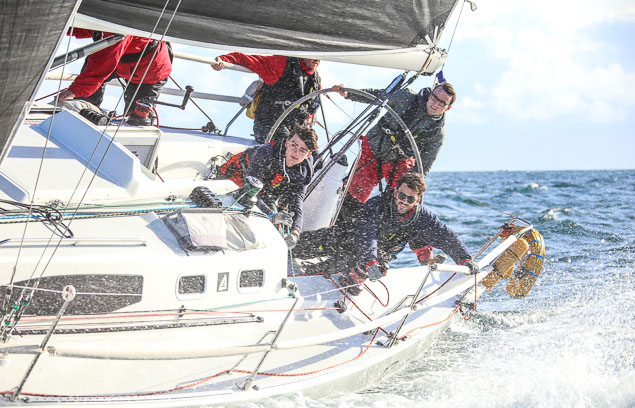 Former ISORA J109 offshore champion Ruth Photo: Afloat.ie
Former ISORA J109 offshore champion Ruth Photo: Afloat.ie
Tip no 9—The less you move the helm, the better. This may seem to be contrary to my comments in Tip no 8, But the reality is moving the helm causes drag and the less you move it , the faster you will be. In Strong winds, with big seas, you will, for sure, need larger helm movement.
In flat water, if you can get the helm at a nice 3-5 degrees of Weather helm, and the boat tracks upwind nicely, then only really small slow movements of the helm are needed. It is another common Helming weakness that I often see, of Helms trying to sail a keelboat, like they are sawing wood. Constant movement. Remember the lift off the rudder is maximized by having weather helm, if you are constantly moving it you go from having no helm for a second to having too much. If you get a lift, a slow push on the helm until you get to the right angle is all that is needed. Likewise, if your weather telltale if lifting showing you are too high, a slow bear off is needed, not a big quick pull.
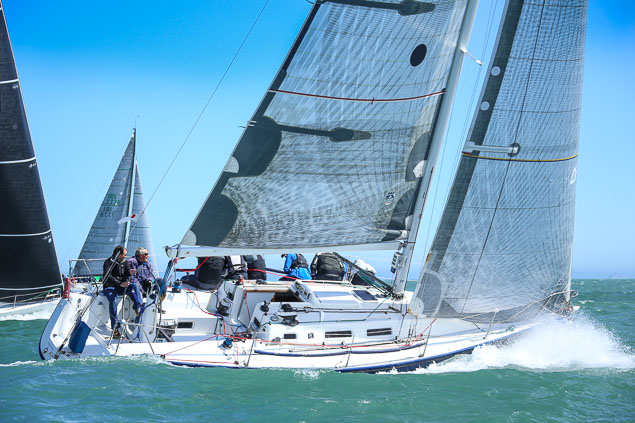 Brian and John Hall's J109, Something Else trucking upwind from with her all-purpose Roller headsail. Sails provided by UK Sailmakers Ireland
Brian and John Hall's J109, Something Else trucking upwind from with her all-purpose Roller headsail. Sails provided by UK Sailmakers Ireland
Tip No 10 Finally, owners could consider getting some Helm coaching. You probably think, I would say this, as I do a lot of coaching, much of it with Helms. However, it is likely the area that can produce the quickest performance gains for the team. There are at least 5 or 6 good keelboat coaches in Ireland, many with good levels of helming experience, and it is well worth considering using one of them.
In my next article on Afloat.ie, I will concentrate on my top 10 tips for steering Downwind, including steering around marks, steering while hoisting and lowering spinnakers, strong wind gybing, preventing both windward broaches and the deadly chinese gybes, steering at starts, light air downwind angle steering and some other topics too.




























































